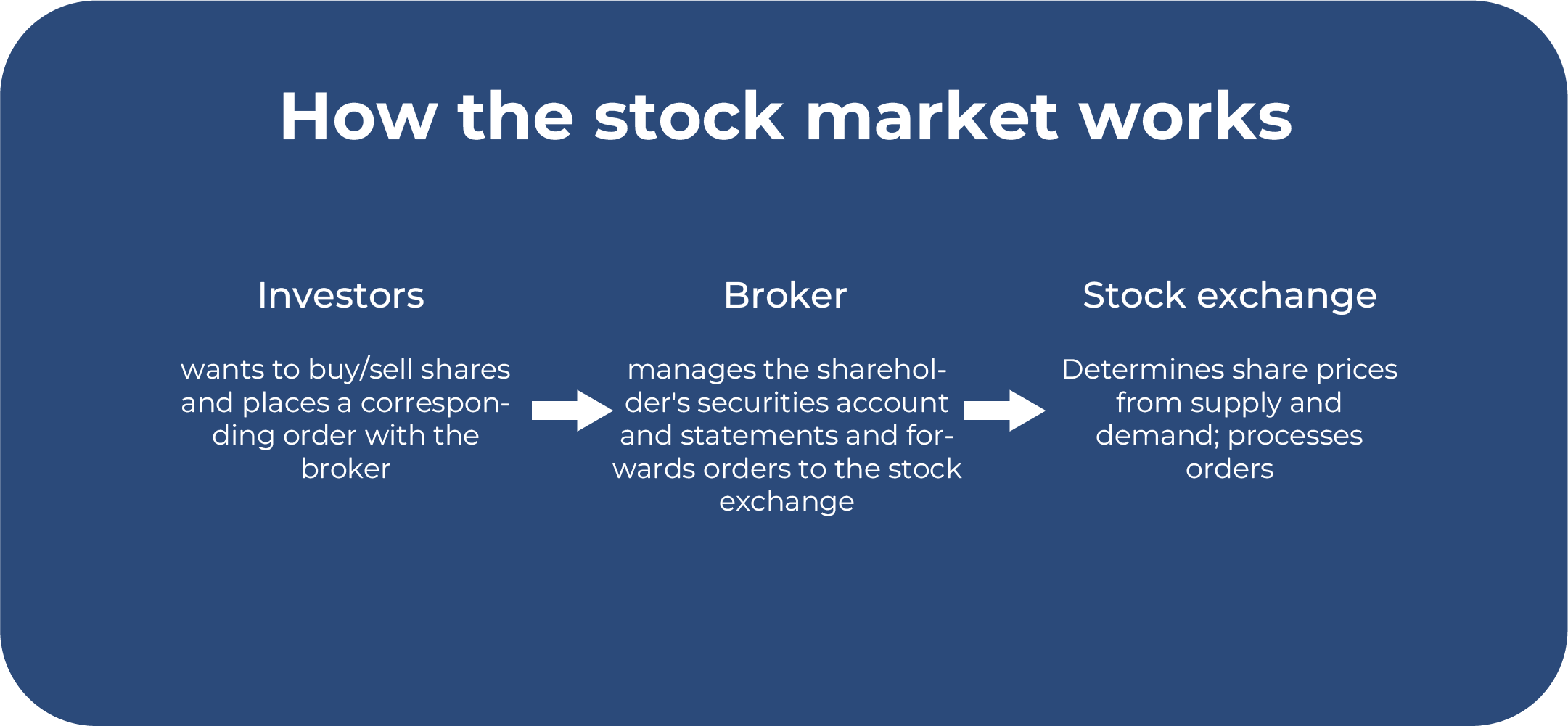Earning money with stocks: How it works


In times of low interest rates and uncertain pensions, more and more people are wondering how they can invest their money to achieve good returns. The aim is to build up wealth. Investing in stocks is also becoming increasingly popular among retail investors. But how exactly do stocks work, what strategies are available and what do you need to bear in mind when investing?
In brief:
- Stocks offer an opportunity to profit from the positive performance of a company.
- The buy-and-hold strategy aims to build long-term wealth with relatively little effort.
- Traders, on the other hand, wanted to make as much profit as possible within a short period of time.
- You should definitely consider these aspects if you want to invest money in stocks.
When you buy a stock, you are buying a share in a company and becoming a co-owner of the group. You can only purchase stocks in companies that are listed on a stock exchange. The price per share varies considerably, ranging from a few pounds to several hundred pounds.
If a company develops positively and generates profits over a long period of time, this is reflected in the value of its shares. The security becomes more and more valuable, allowing you to sell it later at a profit. In this way, you benefit from the company’s performance.
The return on stocks is generally higher than that of other investment options. This is primarily due to the risk involved. No one can predict whether a company will actually make a profit next year or how it will perform. It is also possible that a company could go bankrupt or make losses for many years.
Attention!
Return and risk are always linked. The higher the potential return, the higher the risk. However, there are ways to minimise risk when buying stocks.

Investing in stocks – different strategies
Investors differ in their risk appetite and objectives. Depending on their character and circumstances, they are interested in different investment strategies. Here we look at the two main strategies: buy and hold and trading.
Buy-and-hold
With the buy-and-hold strategy, investors buy stocks and intend to hold them for the long term with the aim of building wealth. These investors want to ensure that they can record profits over the long holding period. They focus on companies with profit potential.
This is one of the most common strategies for investing in stocks. The strategy aims for a holding period of ten years or more. This gives the purchased stocks and companies plenty of time to develop positively.
Investors pursuing this strategy must be resilient to short-term losses in their portfolio. Buy-and-hold investors know that the stock market can be highly volatile, but ultimately it is only long-term performance that counts.
Good to know:
The buy-and-hold strategy is one of the passive methods of investing. This means that investors carefully select stocks once, invest their money, and then do not actively trade.
Diversification can help reduce the risk associated with stocks. The idea is to invest in several stocks from different countries and industries rather than in a single stock. The portfolio can be broadly diversified, which reduces the risk of loss. This investment strategy has several advantages and disadvantages.
Advantages
- The investments work quickly and easily
- A buy-and-hold investor has a good chance of making long-term profits.
- Particularly suitable for investors with a long investment horizon
- With sufficient diversification, the risk of loss is low.
Disadvantages
- Short-term gains are not possible with the buy-and-hold strategy.
- An unsuitable strategy for impatient people
- The capital is tied up long term and cannot be used for other purposes.
- Depending on the asset class, poorly performing stocks may need to be exchanged and replaced.
Good to know:
ETFs are a special asset class for buy-and-hold investors. These are exchange-traded funds that contain a large number of global companies. If an investor focuses on a global MSCI index, for example, the risk of losing money on individual stocks is eliminated. Diversification is increased, which offers greater security. It is also an inexpensive asset class.

Another way to invest in stocks is through trading. This is essentially the opposite of the buy-and-hold strategy. Trading has become increasingly popular due to the speed at which it takes place. The aim is to make as much profit as possible within a short period of time.
Traders profit from highly volatile stocks on the stock market. To trade successfully, it is necessary to obtain sufficient information on the subject in advance. Traders work with chart analyses, for example, and assume recurring patterns in prices.
Trading is generally a risky strategy, as it is impossible to predict with certainty how a company will perform in the short term. It can also be very time-consuming, as investors need to keep up to date with the latest news so as not to miss any trends.

Basics of investing
Regardless of which investment strategy or asset class you choose, there are various aspects to consider. The following tips can help you gain an overview and take various points into account.
Pay off debts before building up assets
Nowadays, you can set up an ETF savings plan with just a small amount of money. Individual shares can sometimes be purchased for just a few pounds. As a general rule, you should only invest money that you don’t need for other things at the moment.
You should also pay off any existing debts before you start investing on the stock market. You should not take on new debts for the purpose of investing, such as borrowing money to be able to invest more. This approach is risky and not advisable.
Find out exactly what your asset class is
It is important to understand exactly what you are investing your money in. Do thorough research in advance to find out how the asset class works. The same applies if you are already looking for specific investment opportunities, such as company shares.
Especially if you are investing in individual stocks, you should take a look at the key figures and the annual report. Forecasts also help to get a good overview. Successful investors, for example, can offer you support based on their experience.
Good to know:
Asset classes such as equity funds can save you time, as less research is required. You invest in several companies, which saves you the effort of reading up on each individual group.
Portfolio diversification
When it comes to investing, it is not advisable to put all your eggs in one basket. Remember to diversify your capital. This means investing your money in different countries, products and industries. Otherwise, you may end up with a so-called cluster risk in your portfolio, which carries certain risks.
For further diversification, you can also invest in different types of investments: whether stocks, certificates, ETFs, bonds, commodities or more, there are numerous options available. After conducting detailed research, you will be better able to assess which asset classes suit you, your goals and your risk tolerance.
Keep calm
When it comes to long-term strategies, it is particularly important that investors remain calm and do not let their emotions get the better of them. The stock market is subject to fluctuations, so it is perfectly normal for your portfolio to be in the red for a while. There will always be economic downturns, but this is not a problem for long-term investments. Take your time to develop a strategy that suits you and stick to it.
Be cautious with stock tips
Time and again, you hear supposedly sure-fire, profitable tips on social media or from acquaintances. There are numerous promises like this, but they are rarely kept. That’s why it’s better to remain sceptical about such advice and instead do your own thorough research so that you can form your own fact-based opinion.

Conclusion: Can you make money with stocks?
With stocks, you can become a co-owner of a company and build wealth. Stocks are characterised by significantly better returns than many other asset classes. However, returns always come with risk, which is why it is important to follow some key rules when investing.
To minimise risk, a long-term buy-and-hold investment strategy is a good option. The aim is to build up assets over many years by buying and holding stocks. Diversification offers additional security. Investors spread their portfolio and invest in different countries and sectors.
Whichever asset class you choose, it is always advisable to obtain detailed information in advance. Investors should also set aside an emergency fund and pay off any debts before investing. If you take the important basics of investing into account, you have a good chance of generating returns in the long term and building up your assets.


